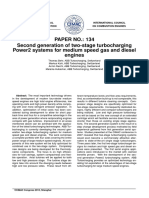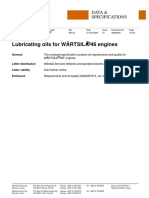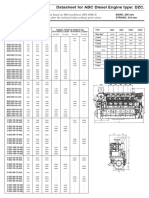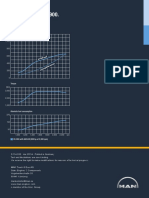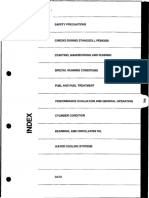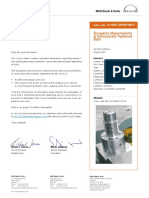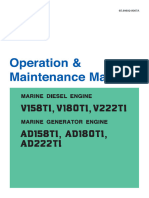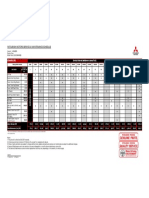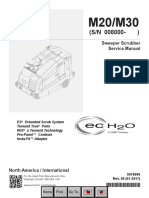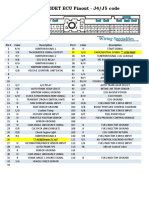Professional Documents
Culture Documents
Cetane Number: University of Karbala College of Engineering Third Stage
Cetane Number: University of Karbala College of Engineering Third Stage
Uploaded by
Mohamed Moder0 ratings0% found this document useful (0 votes)
62 views7 pagesCetane number is a measure of the ignition quality of diesel fuel, with higher numbers indicating faster combustion. Typical cetane numbers range from 48-50 for most diesel engines. European standards require a minimum of 51, while premium fuels can reach as high as 60-63. California diesel requires a minimum cetane number of 53. Neste renewable diesel has an extremely high cetane number of 70-85. Cetane number is measured using specialized testing engines, with the Ignition Quality Tester and Fuel Ignition Tester providing reliable derived cetane number measurements.
Original Description:
Original Title
Cetane number
Copyright
© © All Rights Reserved
Available Formats
PDF, TXT or read online from Scribd
Share this document
Did you find this document useful?
Is this content inappropriate?
Report this DocumentCetane number is a measure of the ignition quality of diesel fuel, with higher numbers indicating faster combustion. Typical cetane numbers range from 48-50 for most diesel engines. European standards require a minimum of 51, while premium fuels can reach as high as 60-63. California diesel requires a minimum cetane number of 53. Neste renewable diesel has an extremely high cetane number of 70-85. Cetane number is measured using specialized testing engines, with the Ignition Quality Tester and Fuel Ignition Tester providing reliable derived cetane number measurements.
Copyright:
© All Rights Reserved
Available Formats
Download as PDF, TXT or read online from Scribd
Download as pdf or txt
0 ratings0% found this document useful (0 votes)
62 views7 pagesCetane Number: University of Karbala College of Engineering Third Stage
Cetane Number: University of Karbala College of Engineering Third Stage
Uploaded by
Mohamed ModerCetane number is a measure of the ignition quality of diesel fuel, with higher numbers indicating faster combustion. Typical cetane numbers range from 48-50 for most diesel engines. European standards require a minimum of 51, while premium fuels can reach as high as 60-63. California diesel requires a minimum cetane number of 53. Neste renewable diesel has an extremely high cetane number of 70-85. Cetane number is measured using specialized testing engines, with the Ignition Quality Tester and Fuel Ignition Tester providing reliable derived cetane number measurements.
Copyright:
© All Rights Reserved
Available Formats
Download as PDF, TXT or read online from Scribd
Download as pdf or txt
You are on page 1of 7
University of Karbala
College of Engineering
Third Stage
Cetane number
By: Karrar Heidar Sarhan
Supervisor: Dr. Haider Nazim
) ( تقرير التدريب الصيفي
● Introduction
Cetane number (cetane rating) is an indicator of the combustion
speed of diesel fuel and compression needed for ignition. It
plays a similar role for diesel as octane rating does for gasoline.
The CN is an important factor in determining the quality of
diesel fuel, but not the only one; other measurements of diesel
fuel's quality include (but are not limited to) energy content,
density, lubricity, cold-flow properties and sulphur content.
Definition:
Cetane number (or CN) is an inverse function of a fuel's
ignition delay, the time period between the start of ignition and
the first identifiable pressure increase during combustion of the
fuel. In a particular diesel engine, higher cetane fuels will have
shorter ignition delay periods than lower Cetane fuels. Cetane
numbers are only used for the relatively light distillate diesel
oils. For heavy (residual) fuel oil two other scales are used,
CCAI and CII.
* Cetane rating unit
● Typical values
Generally, diesel engines operate well with a CN from 48 to
50. Fuels with lower cetane number have longer ignition
delays, requiring more time for the fuel combustion process to
be completed. Hence, higher speed diesel engines operate more
effectively with higher cetane number fuels.
In Europe, diesel cetane numbers were set at a minimum of 38
in 1994 and 40 in 2000. The current standard for diesel sold in
European Union, Iceland, Norway and Switzerland is set in EN
590, with a minimum cetane index of 46 and a minimum cetane
number of 51. Premium diesel fuel can have a cetane number
as high as 60.
In Finland, premium diesel fuels sold by Filling station chains
St1 (Diesel Plus), Shell (containing GTL) and ABC (Smart
Diesel) have a minimum cetane number of 60 with the typical
value being at 63. Neste MY Renewable Diesel sold in Finland
has a minimum cetane number of 70.
In North America, most states adopt ASTM D975 as their
diesel fuel standard and the minimum cetane number is set at
40, with typical values in the 42-45 range. Premium diesel fuel
may or may not have higher cetane number depending on the
supplier. Premium diesel often use additives to improve CN
and lubricity, detergents to clean the fuel injectors and
minimize carbon deposits, water dispersants, and other
additives depending on geographical and seasonal needs.
California diesel fuel has a minimum cetane of 53.
Under the Texas Low Emission Diesel (TxLED) program there
are 110 counties where diesel fuel must have a cetane number
of 48 or greater, or else must use an approved alternative
formulation or comply with the designated alternative limits.
Neste MY Renewable Diesel sold in North America has a
cetane number of 75-85.
● Measuring cetane number
Accurate measurements of the cetane number are rather
difficult, as it requires burning the fuel in a rare diesel engine
called a Cooperative Fuel Research (CFR) engine, under
standard test conditions. The operator of the CFR engine uses a
hand-wheel to increase the compression ratio (and therefore the
peak pressure within the cylinder) of the engine until the time
between fuel injection and ignition is 2.407ms. The resulting
cetane number is then calculated by determining which mixture
of cetane (hexadecane) and isocetane (2,2,4,4,6,8,8-
heptamethylnonane) will result in the same ignition delay.
Ignition Quality Tester (IQT)
Another reliable method of measuring the derived cetane
number (DCN) of diesel fuel is the Ignition Quality Tester
(IQT). This instrument applies a simpler, more robust approach
to CN measurement than the CFR. Fuel is injected into a
constant volume combustion chamber at approximately 575 °C
and 310 psi.
The time between the start of injection and the recovery of the
combustion chamber pressure to 310 psi is defined as the
ignition delay. This measured ignition delay is then used to
calculate the DCN of the fuel. The fuel's DCN is then
calculated using an empirical inverse relationship to ignition
delay. Because of the reproducibility, material cost, and speed
of the IQT, this has been the definitive source for DCN
measurements of fuels since the late 2000s.
Fuel ignition tester
Another reliable method of measuring the derived cetane
number of diesel fuel is the Fuel Ignition Tester (FIT). This
instrument applies a simpler, more robust approach to CN
measurement than the CFR. Fuel is injected into a constant
volume combustion chamber in which the ambient temperature
is approximately 575 °C. The fuel combusts, and the high rate
of pressure change within the chamber defines the start of
combustion. The ignition delay of the fuel can then be
calculated as the time difference between the start of fuel
injection and the start of combustion. The fuel's derived cetane
number can then be calculated using an empirical inverse
relationship to ignition delay.
Cetane index
Another method that fuel-users control quality is by using the
cetane index (CI), which is a calculated number based on the
density and distillation range of the fuel. There are various
versions of this, depending on whether metric or Imperial units
are used, and how many distillation points are used. These days
most oil companies use the '4-point method', ASTM D4737,
based on density, 10% 50% and 90% recovery temperatures.
The '2-point method' is defined in ASTM D976, and uses just
density and the 50% recovery temperature. This 2-point
method tends to overestimate cetane index and is not
recommended. Cetane index calculations can not account for
cetane improver additives and therefore do not measure total
cetane number for additized diesel fuels. Diesel engine
operation is primarily related to the actual cetane number and
the cetane index is simply an estimation of the base
(unadditized) cetane number.
● Reference
- Werner Dabelstein, Arno Reglitzky, Andrea Schütze and
Klaus Reders "Automotive Fuels" in Ullmann's Encyclopedia
of Industrial Chemistry, 2007, Wiley-VCH,
Weinheim.doi:10.1002/14356007.a16_719.pub2
- bosch.de (German) Archived December 24, 2007, at the
Wayback Machine
- "St1 Diesel plus -20 °C Product Data Sheet" (PDF). 2018-03-
15.
- "Shell Diesel Summer -20 °C Product Data Sheet" (PDF).
2018-03-15.
- "NEOT DIESEL -10/-20, NEOT DIESEL -10/-20 Premium
Smart Diesel Data Sheet" (PDF). 2018-03-15.
- "Neste MY Renewable Diesel Product Data Sheet" (PDF).
2019-01-01.
- "Specs table" (PDF). www.arb.ca.gov. Archived from the
original (PDF) on 2017-02-21. Retrieved 2013-06-08.
- "Texas Low Emission Diesel (TxLED) Program". TCEQ.
- "Renewable Diesel Performance: No Odor and Lower
Maintenance". Neste in North America. 2019-02-13. Retrieved
2020-01-15.
- dorfketal.com Archived August 8, 2007, at the Wayback
Machine
You might also like
- N54 Engine.: Aftersales Training - Product InformationDocument68 pagesN54 Engine.: Aftersales Training - Product InformationOmar Khaled Haggag100% (4)
- Manual Moteur S3L2 Mitsubishi - CopieDocument195 pagesManual Moteur S3L2 Mitsubishi - CopieLudwig LevalletNo ratings yet
- Diagrama Sigurante QashqaiDocument9 pagesDiagrama Sigurante QashqaiCristian Dobre100% (1)
- Cetane NumberDocument4 pagesCetane NumberEmad AliNo ratings yet
- Cement Slurry Density TestDocument11 pagesCement Slurry Density TestMohamed ModerNo ratings yet
- Full Paper No 134Document12 pagesFull Paper No 1341542No ratings yet
- A - 15 Service Bulletin: 03.02.97 Technical Information To All Owners of Sulzer A Type Diesel EnginesDocument4 pagesA - 15 Service Bulletin: 03.02.97 Technical Information To All Owners of Sulzer A Type Diesel EnginesgeamuccioNo ratings yet
- Overall Data: Engine Power (ISO 3046 - I) Nominal Power of Gensets KW HP P (KW) P (kVA) P (KW) P (kVA)Document1 pageOverall Data: Engine Power (ISO 3046 - I) Nominal Power of Gensets KW HP P (KW) P (kVA) P (KW) P (kVA)ghostt123No ratings yet
- G80me-C10 6Document570 pagesG80me-C10 6KulovicNo ratings yet
- Service Bulletin A - 3.1: Technical Information To All The Owners of Sulzer A Type Diesel Engines 22.03.96Document8 pagesService Bulletin A - 3.1: Technical Information To All The Owners of Sulzer A Type Diesel Engines 22.03.96zbkt07No ratings yet
- SKF Thap 030Document102 pagesSKF Thap 030seansotoNo ratings yet
- M020 Code Book For Spare Parts, Diesel United - SULZER Diesel Engine RTA72Document227 pagesM020 Code Book For Spare Parts, Diesel United - SULZER Diesel Engine RTA72Matija Segarić100% (1)
- Service Info No. 0016 - ComDocument1 pageService Info No. 0016 - Comcupid75No ratings yet
- 2015 Marine CatalogDocument21 pages2015 Marine CatalogFaraz HaiderNo ratings yet
- HOUTTUIN Catalog GeneralDocument12 pagesHOUTTUIN Catalog GeneralRelu123No ratings yet
- Engine Block and Cylinder Liner V32: Vasa 32 Spare Parts List 100-05Document4 pagesEngine Block and Cylinder Liner V32: Vasa 32 Spare Parts List 100-05mazlum doğan DemirkolNo ratings yet
- Data Sheet 6 8DZCDocument4 pagesData Sheet 6 8DZCRachid KerdidiNo ratings yet
- Service Bulletin A - 14: Technical Information To All The Owners of Sulzer AS25 and AT25 Type Diesel Engines 18.10.96Document3 pagesService Bulletin A - 14: Technical Information To All The Owners of Sulzer AS25 and AT25 Type Diesel Engines 18.10.96Gaetano MuccioNo ratings yet
- Typical Problems Found On Pneumatic Maneuvering SystemDocument9 pagesTypical Problems Found On Pneumatic Maneuvering Systemcengiz kutukcuNo ratings yet
- Man B&W Serv LTR Sl09-511-MtsDocument7 pagesMan B&W Serv LTR Sl09-511-Mtsafsal999No ratings yet
- Description PartsDocument6 pagesDescription PartsDiego Athayde100% (1)
- Adjusting The Camshaft: Tion" in Chapter "Lower Valve Drive"Document25 pagesAdjusting The Camshaft: Tion" in Chapter "Lower Valve Drive"JavierNo ratings yet
- Ss-đã Chuyển ĐổiDocument10 pagesSs-đã Chuyển ĐổiTrần Hoài VinhNo ratings yet
- RTA-55 Exhaust Valve Seat and Exhaust Valve SpindleDocument10 pagesRTA-55 Exhaust Valve Seat and Exhaust Valve SpindleCatalin CataNo ratings yet
- Datasheet For ABC Diesel Engine Type: DZCDocument1 pageDatasheet For ABC Diesel Engine Type: DZCEditya Angga Wijaya100% (1)
- Service Bulletin S - 2: Technical Information To All The Owners of Sulzer S 20 Type Diesel Engines 15.07.94Document5 pagesService Bulletin S - 2: Technical Information To All The Owners of Sulzer S 20 Type Diesel Engines 15.07.94Diego ReggianiniNo ratings yet
- Engine Paramaters Con RodsDocument1 pageEngine Paramaters Con RodsCalandrasReyCalandrasreyNo ratings yet
- Component ServiceDocument7 pagesComponent ServiceFahmi AliNo ratings yet
- Technical Data of Engine: MAN D2840 LE 201: EP 520 Rating at 0.8PF Prime Rating Standby RatingDocument1 pageTechnical Data of Engine: MAN D2840 LE 201: EP 520 Rating at 0.8PF Prime Rating Standby Rating02031989No ratings yet
- Hamworthy WartsilaRTflex96CRTA96CDocument24 pagesHamworthy WartsilaRTflex96CRTA96CTuan Linh VoNo ratings yet
- S26MC - MK - 6 - Project - Guide M20 M25 M32 M43 M281-332C M451-453 M551-552 M601C PDFDocument241 pagesS26MC - MK - 6 - Project - Guide M20 M25 M32 M43 M281-332C M451-453 M551-552 M601C PDFalmonday100% (1)
- ABB Turbocharging TPS - . - D / E - The PerformerDocument4 pagesABB Turbocharging TPS - . - D / E - The PerformerTibor AngeloNo ratings yet
- Rta 54 PDFDocument8 pagesRta 54 PDFAnonymous d00A9zetNo ratings yet
- V8 900 Marine LightDocument4 pagesV8 900 Marine LightNoui BouzidNo ratings yet
- 2-Stroke Engines Cylinder ConditionDocument9 pages2-Stroke Engines Cylinder ConditionKaushalNo ratings yet
- Wartsila 25 Product GuideDocument138 pagesWartsila 25 Product GuideabausersNo ratings yet
- Wartsila Vasa 32 - Spare Parts Notice - Bearing Types For Vasa 32 Based EnginesDocument9 pagesWartsila Vasa 32 - Spare Parts Notice - Bearing Types For Vasa 32 Based Enginesswiatekpiotrwp.plNo ratings yet
- Single Marine Gear UnitsDocument2 pagesSingle Marine Gear UnitsvivekzzNo ratings yet
- 706 - Performance Evaluation and General Operation - 007Document72 pages706 - Performance Evaluation and General Operation - 007Vignesh SivaNo ratings yet
- Nset DC17A PDFDocument1 pageNset DC17A PDFJon SnowNo ratings yet
- Wartsila 18V46 Parts Manual - CompressedDocument433 pagesWartsila 18V46 Parts Manual - CompressedMechanical DeptNo ratings yet
- 1 ManualDocument442 pages1 ManualpgerbzmNo ratings yet
- Lifting Device For Cilind. Liner RTADocument15 pagesLifting Device For Cilind. Liner RTArafael100% (1)
- SL2018 656Document2 pagesSL2018 656argentum19619692No ratings yet
- Geislinger Flexible Coupling Gesilco - 8 0Document57 pagesGeislinger Flexible Coupling Gesilco - 8 0Sebastian Nicușor PărăoanuNo ratings yet
- Tier II Tier III Tier II Tier III: (SFOC) (SFOC)Document1 pageTier II Tier III Tier II Tier III: (SFOC) (SFOC)tijuandrewsNo ratings yet
- SS-7157028-18397893-012 SS Page 1 of 6: Page: M-1 of M-4 © 2017 Caterpillar All Rights Reserved MSS-IND-18397893-006 PDFDocument6 pagesSS-7157028-18397893-012 SS Page 1 of 6: Page: M-1 of M-4 © 2017 Caterpillar All Rights Reserved MSS-IND-18397893-006 PDFПавелNo ratings yet
- Recips John RobbinsDocument43 pagesRecips John Robbinsihsan khan.No ratings yet
- PG M-Iii L2131 PDFDocument488 pagesPG M-Iii L2131 PDFnavy4No ratings yet
- Services by Wartsila BangladeshDocument2 pagesServices by Wartsila Bangladeshakhi5000No ratings yet
- Operation Manual: Issue 001 2019-10Document486 pagesOperation Manual: Issue 001 2019-10Hải Nguyễn VănNo ratings yet
- Manual Doosan V158ti Doosan 2002 Español Parte 2Document90 pagesManual Doosan V158ti Doosan 2002 Español Parte 2Erick ovalleNo ratings yet
- Fuel Oil Specification For WÄRTSILÄ 32 - 3202N053 - 07gbDocument9 pagesFuel Oil Specification For WÄRTSILÄ 32 - 3202N053 - 07gbSidney Pereira JuniorNo ratings yet
- Service Bulletin A - 5: Technical Information To All The Owners of Sulzer A-Type Diesel Engines 11.07.85Document7 pagesService Bulletin A - 5: Technical Information To All The Owners of Sulzer A-Type Diesel Engines 11.07.85zbkt07100% (1)
- Fuels, Fuel Preparation: Technical BulletinDocument14 pagesFuels, Fuel Preparation: Technical BulletinEduard Florez Efres100% (1)
- Maintenance Schedule XPANDERDocument1 pageMaintenance Schedule XPANDERNUR HUMAIRANo ratings yet
- ManDocument1 pageManbastechNo ratings yet
- M001 eDocument12 pagesM001 eAdolfo BurgosNo ratings yet
- Wartsila OemDocument2 pagesWartsila OemAbid LakhaniNo ratings yet
- Cylinder Lubricator Unit: MAN B&W DieselDocument2 pagesCylinder Lubricator Unit: MAN B&W DieselFaustoJuniorNo ratings yet
- 628Document4 pages628sdiamanNo ratings yet
- Technische Daten D 2876 LE 20x-EngDocument3 pagesTechnische Daten D 2876 LE 20x-EngFahad MohammedNo ratings yet
- Cetane NumberDocument5 pagesCetane NumbereliotroyanoNo ratings yet
- Cetane NumberDocument4 pagesCetane NumberSudarshanBhardwajNo ratings yet
- Solution of The Assignment ProblemDocument5 pagesSolution of The Assignment ProblemMohamed ModerNo ratings yet
- Chapter 01 Introduction - PosterDocument45 pagesChapter 01 Introduction - PosterMohamed ModerNo ratings yet
- Chapter 3 - Microscopic Displacement Eficiency - Part IIDocument40 pagesChapter 3 - Microscopic Displacement Eficiency - Part IIMohamed ModerNo ratings yet
- The Transportation Problem: Transport Sources DestinationsDocument13 pagesThe Transportation Problem: Transport Sources DestinationsMohamed ModerNo ratings yet
- Chapter 2 - Factors Impacting Water FloodingDocument42 pagesChapter 2 - Factors Impacting Water FloodingMohamed ModerNo ratings yet
- Fundamentals of ValvesDocument28 pagesFundamentals of ValvesMohamed ModerNo ratings yet
- The Bisection Method by MATHLAPDocument5 pagesThe Bisection Method by MATHLAPMohamed ModerNo ratings yet
- Plunger LiftDocument3 pagesPlunger LiftMohamed ModerNo ratings yet
- Separators: Figure OneDocument8 pagesSeparators: Figure OneMohamed Moder100% (1)
- Liquid Permeability Measurement ExperimentDocument14 pagesLiquid Permeability Measurement ExperimentMohamed Moder100% (1)
- Contact Angle Measurement Using Imaging MethodDocument16 pagesContact Angle Measurement Using Imaging MethodMohamed ModerNo ratings yet
- Core Plugging: University of Karbala College of Engineering Reservoir Engineering Lab Third StageDocument9 pagesCore Plugging: University of Karbala College of Engineering Reservoir Engineering Lab Third StageMohamed Moder100% (1)
- Hyundai HD Series: Dimensions (MM)Document4 pagesHyundai HD Series: Dimensions (MM)Hewa PCNo ratings yet
- 01 121117 FPTIndustrial NewF36 HIeSCR2Document3 pages01 121117 FPTIndustrial NewF36 HIeSCR2RasoolKhadibiNo ratings yet
- Previous Cargo: BP Tank Cleaning GuideDocument1 pagePrevious Cargo: BP Tank Cleaning GuideChetan100% (1)
- Fuel Consumption & THP Table 16-710G3C-ES - GT46ACDocument1 pageFuel Consumption & THP Table 16-710G3C-ES - GT46ACRafael Dutil LucianaNo ratings yet
- Generador Generac GP SeriesDocument68 pagesGenerador Generac GP SeriesfoxhoundforcesNo ratings yet
- Yanmar Diesel Tractor EF494T Operator's ManualDocument81 pagesYanmar Diesel Tractor EF494T Operator's ManualBuba benNo ratings yet
- Electrico Interactivo PDFDocument38 pagesElectrico Interactivo PDFFelipeNicolasSilvaNo ratings yet
- Induction Material MoPnGDocument60 pagesInduction Material MoPnGRaghvendra UpadhyaNo ratings yet
- Comparative Analysis of Carburetor and Fuel Injection SystemDocument17 pagesComparative Analysis of Carburetor and Fuel Injection SystemPrabesh Poudel100% (1)
- Sweeper Scrubber Service ManualDocument146 pagesSweeper Scrubber Service ManualCodeiro SilvaNo ratings yet
- Chevrolet Pinout Diagrama SPARK 2001 MatizDocument3 pagesChevrolet Pinout Diagrama SPARK 2001 MatizJarlinson Oyuela100% (1)
- Mitsubishi Electronics mgs2700c Manual de UsuarioDocument4 pagesMitsubishi Electronics mgs2700c Manual de UsuarioEsteban JaramilloNo ratings yet
- Gas Station QuestionnaireDocument4 pagesGas Station QuestionnaireDilshadNo ratings yet
- ICE PresentationDocument19 pagesICE PresentationManish SNo ratings yet
- 6 Peter Nerenst Experience ShareDocument118 pages6 Peter Nerenst Experience ShareŞansal DikmenerNo ratings yet
- Öğrenci Yük İstif UygulamalarıDocument59 pagesÖğrenci Yük İstif UygulamalarıMehmet BaşNo ratings yet
- CFMoto CF500-5B - CF500-5C Service ManualDocument272 pagesCFMoto CF500-5B - CF500-5C Service ManualDanNo ratings yet
- ISB Fault Codes: A Complete List of All ISM Codes For Cummins Diesel Engines With EGR SystemsDocument5 pagesISB Fault Codes: A Complete List of All ISM Codes For Cummins Diesel Engines With EGR SystemsEduardo TorresNo ratings yet
- S13 SR20 ECU Pinout J4J5Document2 pagesS13 SR20 ECU Pinout J4J5CelsoBrantesNo ratings yet
- L180E-Engine - Fuel System, DescriptionDocument3 pagesL180E-Engine - Fuel System, Descriptionyoga_jpbmbmNo ratings yet
- WL Common-Rail EN - WEBDocument3 pagesWL Common-Rail EN - WEBemmsh71No ratings yet
- Entity Level GHG Survey (2019)Document2 pagesEntity Level GHG Survey (2019)Dominic CareoNo ratings yet
- Lucas L Electronic Fuel Injection: As Fitted To The 3528Cc V8 Engine Installed in The Rover Sd1 Vitesse and Efi VDPDocument35 pagesLucas L Electronic Fuel Injection: As Fitted To The 3528Cc V8 Engine Installed in The Rover Sd1 Vitesse and Efi VDPAleksandar AdlerNo ratings yet
- Takeuchi Track Loader Engine V3800di T 3b Tltu 1 Parts ManualDocument10 pagesTakeuchi Track Loader Engine V3800di T 3b Tltu 1 Parts ManualWillis100% (57)
- IMPCO Master PartsDocument468 pagesIMPCO Master PartsAndrés Toro100% (2)
- Stephen L. Hightower II, Chief Operating Officer of Hightowers Petroleum Co. Appointed To Cincinnati Regional Chamber Board of DirectorsDocument2 pagesStephen L. Hightower II, Chief Operating Officer of Hightowers Petroleum Co. Appointed To Cincinnati Regional Chamber Board of DirectorsPR.comNo ratings yet
- Case Study Turbocharger 2Document2 pagesCase Study Turbocharger 2Sam BakkerNo ratings yet





